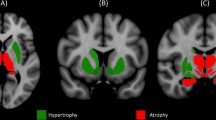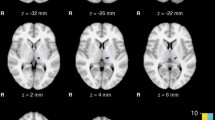Abstract
Essential tremor (ET) is one of the most common movement disorders. However, few studies regarding the differences of pathophysiology according to phenotypes of ET have been reported. We investigated whether a functional difference occurs between ET with only a limb tremor (L-ET) and ET with only a head tremor (H-ET). We recruited 13 patients with L-ET, 10 patients with H-ET, and 33 healthy subjects. We compared the severity of tremor symptoms using the Fahn-Tolosa-Marin rating scale (FTM) to compare L-ET with H-ET. All subjects underwent magnetic resonance imaging and perfusion SPECT of the brain. The total score of FTM was significantly higher in the L-ET than in the H-ET. However, Part A in FTM did not show significant differences between the two ET groups. A brain perfusion SPECT analysis demonstrated no significant difference between L-ET and H-ET, but a regional perfusion of subjects with ET compared with healthy subjects showed hypoperfusion in the insular, cingulate gyrus, frontal lobe, and cerebellum. In conclusion, we suggested that cerebellar dysfunction might be involved in the pathogenesis of ET. In addition, we assumed that ET has the same pathogenesis in the origin of the disease, regardless of the clinical difference of ET.


Similar content being viewed by others
References
Lorenz D, Deuschl G (2007) Update on pathogenesis and treatment of essential tremor. Curr Opin Neurol 20:447–452
Teive HA (2012) Essential tremor: phenotypes. Parkinsonism Relat Disord 18(Suppl 1):S140–S142
Louis ED (2005) Essential tremor. Lancet Neurol 4:100–110
Jankovic J (2002) Essential tremor: a heterogenous disorder. Mov Disord 17:638–644
Whaley NR, Putzke JD, Baba Y, Wszolek ZK, Uitti RJ (2007) Essential tremor: phenotypic expression in a clinical cohort. Parkinsonism Relat Disord 13:333–339
Hallett M, Dubinsky RM (1993) Glucose metabolism in the brain of patients with essential tremor. J Neurol Sci 114:45–48
Boecker H, Brooks DJ (1998) Functional imaging of tremor. Mov Disord 13(Suppl 3):64–72
Louis ED, Shungu DC, Chan S et al (2002) Metabolic abnormality in the cerebellum in patients with essential tremor: a proton magnetic resonance spectroscopic imaging study. Neurosci Lett 333:17–20
Quattrone A, Cerasa A, Messina D et al (2008) Essential head tremor is associated with cerebellar vermis atrophy: a volumetric and voxel-based morphometry mr imaging study. AJNR Am J Neuroradiol 29:1692–1697
Louis ED, Vonsattel JP, Honig LS et al (2006) Essential tremor associated with pathologic changes in the cerebellum. Arch Neurol 63:1189–1193
Louis ED, Vonsattel JP, Honig LS et al (2006) Neuropathologic findings in essential tremor. Neurology 66:1756–1759
Deuschl G, Bain P, Brin M (1998) Consensus statement of the movement disorder society on tremor. Ad hoc scientific committee. Mov Disord 13(Suppl 3):2–23
Louis ED, Ford B, Barnes LF (2000) Clinical subtypes of essential tremor. Arch Neurol 57:1194–1198
Deuschl G, Lucking CH, Schenck E (1987) Essential tremor: electrophysiological and pharmacological evidence for a subdivision. J Neurol Neurosurg Psychiatry 50:1435–1441
Deuschl G, Wenzelburger R, Loffler K, Raethjen J, Stolze H (2000) Essential tremor and cerebellar dysfunction clinical and kinematic analysis of intention tremor. Brain 123(Pt 8):1568–1580
Klein JC, Lorenz B, Kang JS et al (2011) Diffusion tensor imaging of white matter involvement in essential tremor. Hum Brain Mapp 32:896–904
Rao AK, Gillman A, Louis ED (2011) Quantitative gait analysis in essential tremor reveals impairments that are maintained into advanced age. Gait Posture 34:65–70
Benito-Leon J, Alvarez-Linera J, Hernandez-Tamames JA et al (2009) Brain structural changes in essential tremor: voxel-based morphometry at 3-tesla. J Neurol Sci 287:138–142
Bagepally BS, Bhatt MD, Chandran V et al (2012) Decrease in cerebral and cerebellar gray matter in essential tremor: a voxel-based morphometric analysis under 3T MRI. J Neuroimaging 22:275–278
Nicoletti G, Manners D, Novellino F et al (2010) Diffusion tensor mri changes in cerebellar structures of patients with familial essential tremor. Neurology 74:988–994
Paris-Robidas S, Brochu E, Sintes M et al (2012) Defective dentate nucleus gaba receptors in essential tremor. Brain 135:105–116
Louis ED, Faust PL, Vonsattel JP et al (2007) Neuropathological changes in essential tremor: 33 cases compared with 21 controls. Brain 130:3297–3307
Louis ED (2010) Essential tremor: evolving clinicopathological concepts in an era of intensive post-mortem enquiry. Lancet Neurol 9:613–622
Louis ED, Vonsattel JP (2008) The emerging neuropathology of essential tremor. Mov Disord 23:174–182
Nagai M, Kishi K, Kato S (2007) Insular cortex and neuropsychiatric disorders: a review of recent literature. Eur Psychiatry 22:387–394
Benito-Leon J, Louis ED, Bermejo-Pareja F, Neurological Disorders in Central Spain Study G (2006) Population-based case-control study of cognitive function in essential tremor. Neurology 66:69–74
Acknowledgments
This work was supported by the Global Frontier R&D Program on “Human-centered Interaction for Coexistence” funded by the National Research Foundation of Korea grant funded by the Korean Government (MEST) (2013-056221).
Author information
Authors and Affiliations
Corresponding author
Rights and permissions
About this article
Cite this article
Song, IU., Park, JW., Chung, SW. et al. Differences in cerebral perfusion according to phenotypes of essential tremor: brain perfusion SPECT study using SPM analysis. Neurol Sci 35, 767–772 (2014). https://doi.org/10.1007/s10072-013-1600-9
Received:
Accepted:
Published:
Issue Date:
DOI: https://doi.org/10.1007/s10072-013-1600-9




